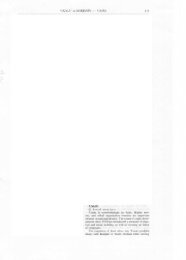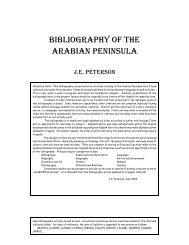THE ARABIAN PENINSULA IN MODERN TIMES: A - JEPeterson.net
THE ARABIAN PENINSULA IN MODERN TIMES: A - JEPeterson.net
THE ARABIAN PENINSULA IN MODERN TIMES: A - JEPeterson.net
You also want an ePaper? Increase the reach of your titles
YUMPU automatically turns print PDFs into web optimized ePapers that Google loves.
Other social histories deal with more specific topics. Aspects of women’s lives and<br />
restricted roles in society have been studied by Eleanor Doumato in Saudi Arabia and the Gulf,<br />
Sophia Pandy in Bahrain, and Ulrike Freitag and Hanne Schönig in South Yemen. Another<br />
approach is Penelope Tuson’s look at Western women in Arabia. 50 Although the people of the<br />
Peninsular are predominantly Arab and Muslim, it should not be forgotten that the region is<br />
also home to an intriguing variety of religious, social, and/or ethnic minorities and communities<br />
who, in many cases, have been in the Peninsula for centuries. Some of these, such as the<br />
hawwalah (Arabs from the Persian coast who resettled on the Arab littoral of the Gulf) and the<br />
Baluch (originally from the Pakistani and Iranian coast) have received little attention (except for<br />
Beatrice Nicolini’s article). Fortunately, however, Nelida Fuccaro has looked at Persians in<br />
Bahrain, Anie Montigny at Africans in Qatar (as well as Arabs in Iran), and Marc Valeri at<br />
“Zanzibaris” in Oman. 51 The role of Western medical missionaries in the Peninsula from the<br />
late 19 th century on remains a fascinating topic, attracting the attention of Eleanor Doumato for<br />
the Gulf, Fatma al‐Sayegh for American missionaries in the UAE, Paul Armerding for American<br />
missionaries in Saudi Arabia, Lucile Fevrier for French missionaries in Yemen, and J.H. Proctor<br />
for Scottish missionaries in South Arabia. 52<br />
More cultural contributions include Nicolas Gavrielides on historical memory in Iraq and<br />
Kuwait, Nadia Rahman on the memory of UAE elders, Ulrike Freitage on the press in Yemen’s<br />
Hadramawt, and Bernard Haykel on legal proceedings in 18 th ‐century Yemen. 53 Architectural<br />
Arabicus Felix: Luminosus Britannicus; Essays in Honour of A.F.L. Beeston on his Eightieth Birthday (Oxford:<br />
Ithaca Press, 1991), pp. 8-24; Donald P. Cole and Soraya Altorki, “Was Arabia Tribal? A Reinterpretation of the<br />
Pre-Oil Society,” Journal of South Asian and Middle Eastern Studies, Vol. 15, No. 4 (1992), pp. 71-87; Donald P.<br />
Cole, “Where have the Bedouin Gone?” Anthropological Quarterly, Vol. 76, No. 2 (Spring 2003), pp. 235-267; Anh<br />
Nga Longva, “Nationalism in Pre-Modern Guise: The Discourse on Hadhar and Badu in Kuwait,” International<br />
Journal of Middle East Studies, Vol. 38, No. 2 (May 2006), pp. 171-187.<br />
50. Ulrike Freitag and Hanne Schönig, “Wise Men Control Wasteful Women: Documents on ‘Customs and<br />
Tradition’ in the Kathiri State Archive, Say’un,” New Arabian Studies, Vol. 5 (2000), pp. 67-96; Eleanor Abdella<br />
Doumato, Getting God’s Ear: Women, Islam, and Healing in Saudi Arabia and the Gulf (New York: Columbia<br />
University Press, 2000); Penelope Tuson, Playing the Game: The Story of Western Women in Arabia, 1892-1939<br />
(London: I.B. Tauris, 2003); Sophia Pandy, “Muslim Women’s Changing Religious Practices in Bahrain: The<br />
Impact of Modern Education” (Ph.D. dissertation, University of California, Santa Barbara, June 2006).<br />
51. Anie Montigny, “Les Arabes de l’autre rive,” CEMOTI (Cahiers d’études sur la Méditerranée orientale et le<br />
monde turcoiranien), No. 22 (July-December 1996), pp. 51-81; ibid., “L’Afrique oubliée des noirs du Qatar,”<br />
Journal des Africanistes, Vol. 72, No. 2 (2002), pp. 213-225; Nelida Fuccaro, “Mapping the Transnational<br />
Community: Persians and the Space of the City in Bahrain, c.1869-1937,” in Madawi Al-Rasheed, ed.,<br />
Transnational Connections and the Arab Gulf (London: RoutledgeCurzon, 2005), pp. 38-58; Marc Valeri, “Nation-<br />
Building and Communities in Oman Since 1970: The Swahili-Speaking Omani in Search of Identity,” African<br />
Affairs, Vol. 106, No. 424 (July 2007), pp. 479-496; Beatrice Nicolini, “The Baluch Role in the Persian Gulf During<br />
the Ni<strong>net</strong>eenth and Twentieth Centuries,” Comparative Studies of South Asia, Africa and the Middle East, Vol. 27,<br />
No. 2 (2007), pp. 384-395.<br />
52. Fatma al-Sayegh, “American Missionaries in the UAE Region in the Twentieth Century,” Middle Eastern<br />
Studies, Vol. 32, No. 1 (January 1996), pp. 120-139; Lucile Fevrier, Yemen: Evénements vécus: Médecine<br />
coopérative française sur fond de révolution (Sint-Martens-Latem, Belgium: Les Editions de la Dyle, 2002);<br />
Eleanor Abdella Doumato, “An ‘Extra Legible Illustration’ of the Christian Faith: Medicine, Medical Ethics and<br />
Missionaries in the Arabian Gulf,” Islam and Christian-Muslim Relations, Vol. 13, No. 4 (October 2002), pp. 377-<br />
390; Paul Armerding, Doctors for the Kingdom: The Work of the American Mission Hospitals in the Kingdom of<br />
Saudi Arabia, 1913-1955 (Grand Rapids, MI: Erdmans, 2003); J.H. Proctor, “Scottish Medical Missionaries in<br />
South Arabia, 1886-1979,” Middle Eastern Studies, Vol. 42, No. 1 (January 2006), pp. 103-121.<br />
53. Nicolas Gavrielides, “State Formation, Historical Memory and Popular Culture in Iraq and Kuwait,” in Eric<br />
16







